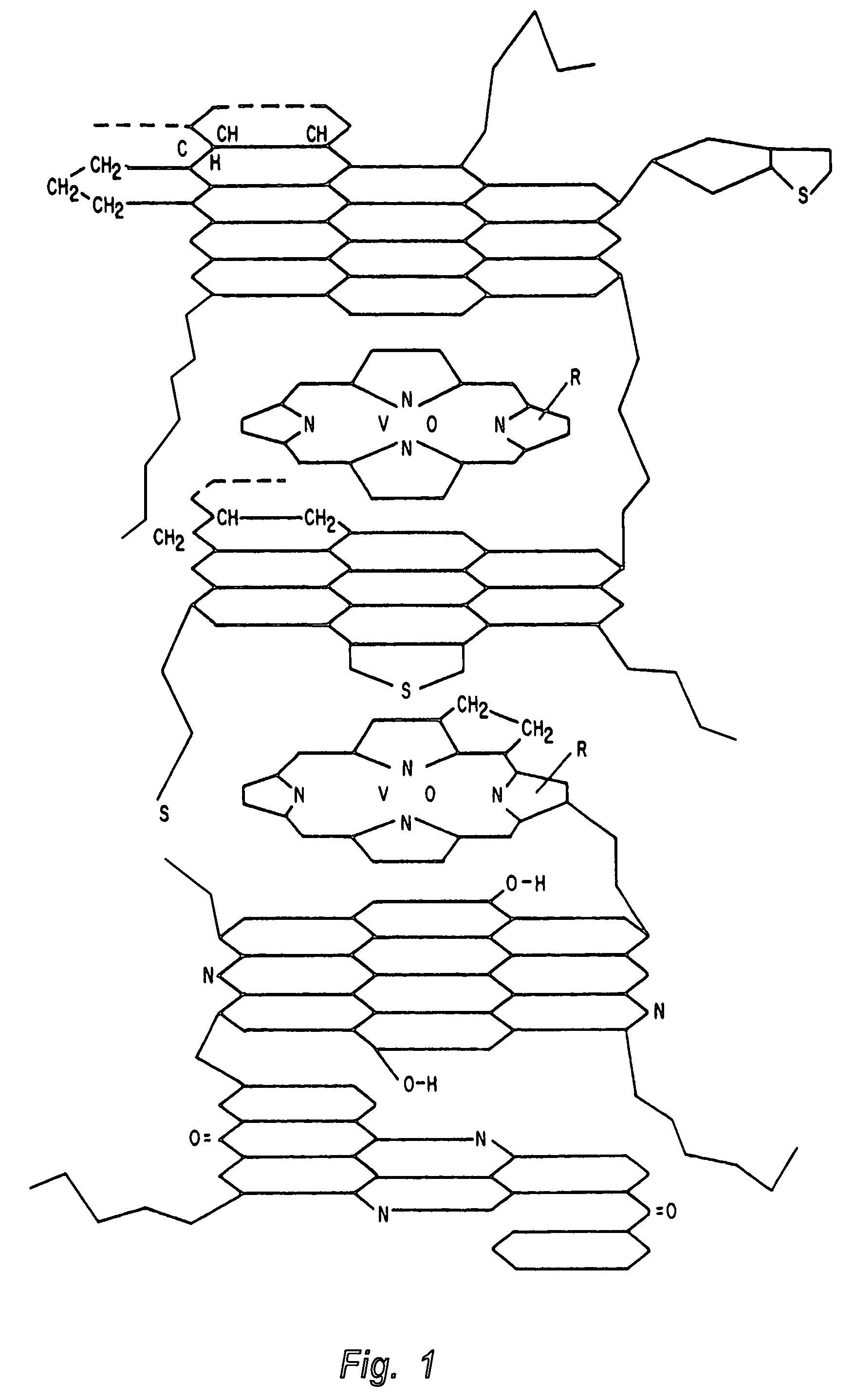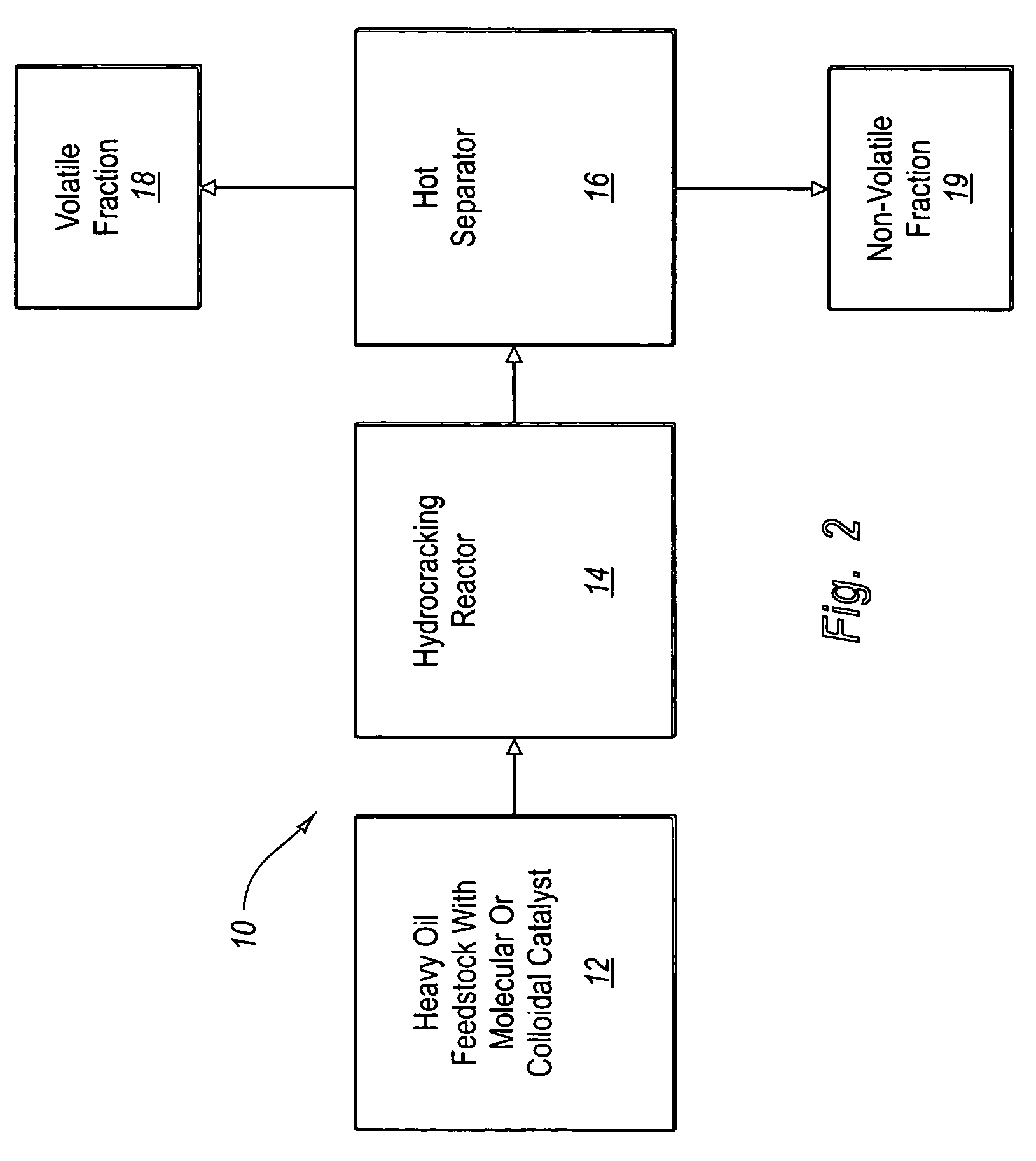Hydroprocessing method and system for upgrading heavy oil using a colloidal or molecular catalyst
a technology of colloidal or molecular catalyst and heavy oil, which is applied in the direction of catalyst activation/preparation, catalyst regeneration/reactivation, physical/chemical process catalyst, etc., can solve the problems of reducing the operating life of equipment and increasing the risk of mechanical integrity damage, so as to reduce equipment fouling, inhibit or eliminate the formation of coke precursors and sediments, and effectively process asphaltene molecules
- Summary
- Abstract
- Description
- Claims
- Application Information
AI Technical Summary
Benefits of technology
Problems solved by technology
Method used
Image
Examples
example 1
[0137]The ability of a colloidal or molecular catalyst and a porous supported catalyst to convert the asphaltene fraction of a heavy oil feedstock was compared. A heavy oil feedstock comprising Cold Lake bitumen atmospheric resid and 300 ppm of a molybdenum disulfide catalyst in colloidal or molecular form was introduced into a pilot slurry phase hydroprocessing reactor system and operated at various percent resid conversion levels. The pilot reactor system used in this test was similar to that shown in FIG. 13 (discussed more fully below), except that the pilot reactor system only had a single continuous flow slurry phase reactor having a volume of 1200 ml. The pilot reactor was a hollow tube and had no internal liquid recycle system. The pilot plant experiments were carried out under 2000 psig of hydrogen pressure, with a reaction temperature over the range of 430-450° C. to control the conversion level and a hydrogen flow rate of 5000 standard cubic feet per barrel of heavy oil (...
example 2
[0141]A heavy oil feedstock comprising Athabasca vacuum tower bottoms (which included 21 wt. % of pentane insoluble asphaltenes) from the Syncrude Canada Ltd. plant in Alberta, Canada, with 150 ppm of a molybdenum sulfide catalyst in colloidal or molecular form was introduced into a pilot plant similar to the one shown in FIG. 13 having two gas-liquid slurry phase reactors connected in series. Each reactor had a volume of 2200 ml. The first reactor was heated to a weighted averaged temperature below 370° C. (698° F.), and the second reactor was heated to a weighted averaged temperature between 419-445° C. (786-833° F.) and liquid hourly space velocity between 0.41 and 0.7 / hr. The results of this test showed that the concentration of the asphaltene in the residual resid at 75% conversion was also 21 wt. %, which was identical to that in the original feedstock, thereby further confirming the ability of the colloidal or molecular catalyst to convert the asphaltene fraction at the same ...
example 3
[0142]This example tested the ability of a colloidal or molecular catalyst utilized in a slurry phase reactor according to the invention to convert various resid materials and their asphaltene and sulfur fractions at high conversion rates. The pilot plant used in this example was the same slurry phase, tubular reactor described in Example 1. In each test, the heavy oil feedstock was thoroughly mixed with up to 250 parts per million of the catalyst precursor over a prolonged period of time before being introduced to the reactor. The reactor temperature was maintained between 430-450° C. to control the conversion level. The reactor pressure was 2000 psig and the hydrogen treat rate was 5000 standard cubic feet per barrel of heavy oil. The results of this test are set forth in Table I below:
[0143]
TABLE IFeedstockChineseParaffinicAthabascaCold LakeMaya / IsthmusBottomsBitumenBottomsBlendBlend975° F.+ resid94946395conversion, wt %Asphaltene (C5 Ins.)95936796conversion wt %Sulfur conversion...
PUM
| Property | Measurement | Unit |
|---|---|---|
| boiling point | aaaaa | aaaaa |
| boiling point | aaaaa | aaaaa |
| temperature | aaaaa | aaaaa |
Abstract
Description
Claims
Application Information
 Login to View More
Login to View More - R&D
- Intellectual Property
- Life Sciences
- Materials
- Tech Scout
- Unparalleled Data Quality
- Higher Quality Content
- 60% Fewer Hallucinations
Browse by: Latest US Patents, China's latest patents, Technical Efficacy Thesaurus, Application Domain, Technology Topic, Popular Technical Reports.
© 2025 PatSnap. All rights reserved.Legal|Privacy policy|Modern Slavery Act Transparency Statement|Sitemap|About US| Contact US: help@patsnap.com



